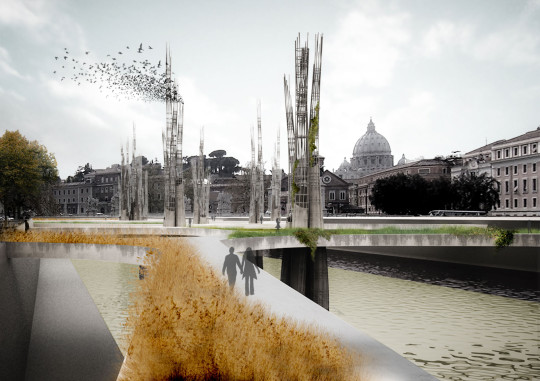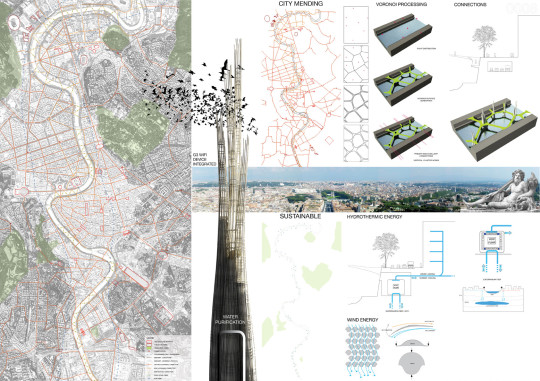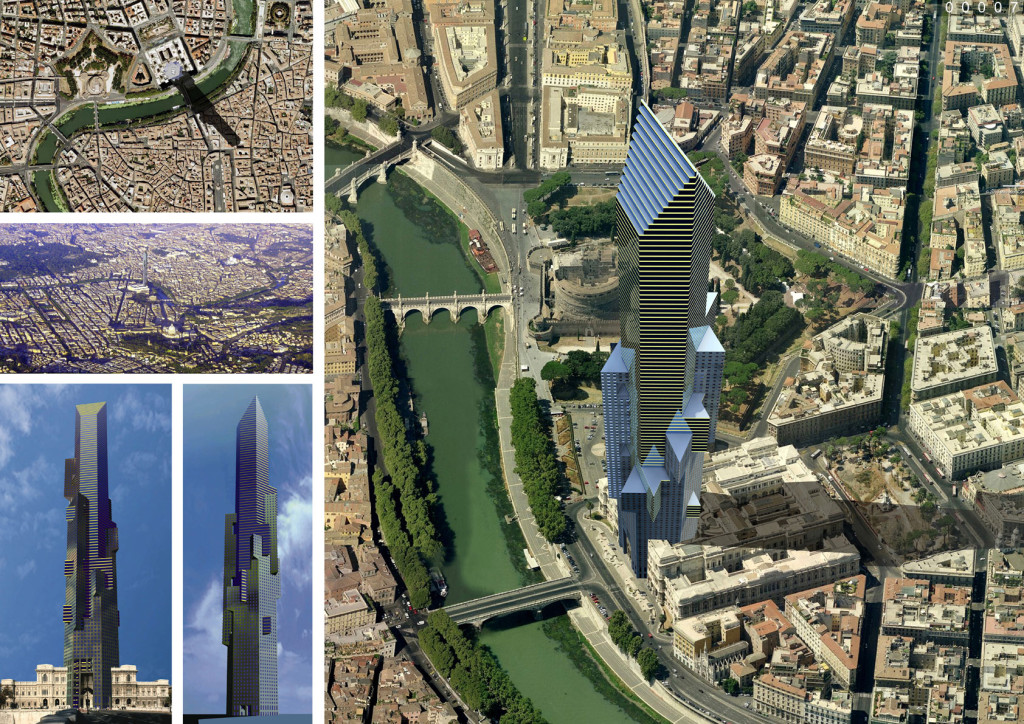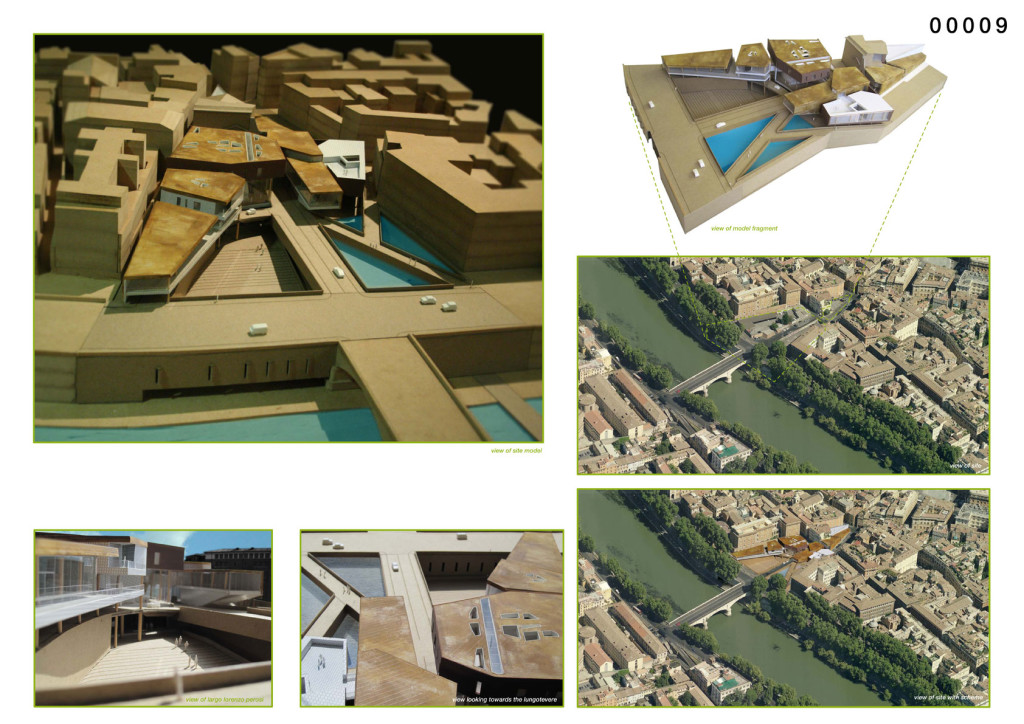Info:
Title: History of Rome - Code: 00008Contest: Rome / 2010
By: M. Gabay / G. Maciocci
Views: 3478 Likes: 0
Votes:
JUERGEN MAYER H. 0 FRANCESCO LIPARI4 FELIPE ESCUDERO5 FRANCESCO GATTI 8 MICHAEL CATON 105.4
History of Rome


|
HISTORY OF ROME
The history of Rome starts hundred thousands years ago, when two volcanoes emerged from the sea, erupting one towards the other, creating a valley in between them. The sea, that first reached the Appenins mountains, slowly flowed down, eroding the landscape and leaving a stratus of mineral deposit: the valley of the paleo-Tiber. The main flow converged between the Palatino and the Aventino hills, defining the morphology of the Circo Massimo stadium. The secondary flows created the 7 hills topography of the ancient city. The myth relates that Romolus and Remus where brought by the river in a basket to the foot of the Palatino hill, where the Wolf found and breed them. The city they founded first developped in the heights, on the hills surrounded by swamps. Then it expanded, reaching the other side of the river, crossing it twice in its narrowest part: the Tiberian Island, arisen from geological deposit between the Aventino and the Gianicolo hills. Here took place exchange between Romans and Etruscans. Indeed Rome’s existence and its actual state are deeply related to its geological and hydrological history.
ROME AND THE TIBER
For centuries, Rome found in the Tiber its main economic ressource. From the harbour of Ostia the merchandise arrived in the center of the city, and the commercial life took place along the docks. Even in the Renaissance period there has been a developping of the commercial and social use of the river. The relation between the city and the river was primordial. As Roesler Franz paintings testify, the ancient city arose in the water. But, as the great archeologist Rodolfo Lanciani says, the great works made by the Lombards for the Unity of Italy, constricted the Tiber between two high walls, confering him a monotony in its landscape, erasing his ancestral identity. These walls were even over dimensioned, therefore nowadays the only way to relate with the river is from above, from the birdges or the hills.
TERRITORIAL ORGANISATION
The Tiber is a potential connection between the center and the suburbs, between the modern and the ancient city. It is surely the greatest unexploited ressource in Rome, as it can be fundamental for its sustainable development. It could also help responding to the increasing tourism, and therefore economically developing the city in the next decades.
The aim of the project is to create both a longitudinal urban scale connection system and the transversal connections all along the Tiber: an ecological axis crossed by transversal green connections in the city, through a landscape scale conception. The Tiber as a new green infrastructure of the city, mending its two parts it today divides and at the same time improving connections in a larger urban scale. The role of the Tiber is thus reconfigured as an urban, environmental, social and economic infrastructure as it was before the literal rise of the city, through urbanisation, and the erection of the flood walls that phisically and perceptively detached the river from it’s context.
SUSTAINABILITY
The creation of new Tiber crossing connections, would improve the pedestrian/cyclable, and therefore sustainable, use of the city. These connections intend to mend the two parts of Rome. They are parametrically configured through the exploration of voronoi systems to produce interconnected systems of flow emerging from the existing urban connections and continuities/discontinuities. This surface rests upon tower clusters that rise from the river, creating a new character and identity for the Tiber and the city.
The towers clusters operate as water filters and nutrient distribution nodes. Water from the river is taken up into the the system via a system of capillary conduits that form the tubular structure of the individual towers. The solid central core of each tower houses a system of membrane and microbial filters and pumps that circulate the water through the filration mechanism.
The cleaner water is circulated constantly through the system in both the tower clusters and voronoi surface. Together these elements form a vast capillary filtration network that seeks to ameliorate the level of contamination of the river due to the effects of intense urbanisation. Once passed through the system, the water is purified further by passing through the root zone of the vegetation growing on the voronoi surface. Local species of grasses and reeds are used for their water purification attributes as well as their ease of growth and control within an artificial growth system. The water is then discharged back into the river and is progressively decontaminated and purified passes through each †tower cluster successively. The cleaner state of the river will provide a cleaner acquatic environment for the city to enjoy through water based activities such as canoing, swimming and diving where the flow of the river is slow enough to allow it.
The underside of the entire Voronoi surface is differentiated to exploit the wind currents created by flow of cold water in the river and the hotter, hard surface of the city. The wind currents are transformed into electricity via a modular skin of piezoelectric fins or scales. Each scale is a self-contained micro piezoelectric generator and is composed of a piezoelectric film within a thin, flexible skin. As the scales deform under the influence of air currents they generate a small amount of electricity. Modular panels of roughly 100 scales each (1m x 1m) operate as batteries storing the energy produced by the scales. The energy produced and stored is later directed to the tower clusters via cabling within the voronoi surface for artificial lighting, pumps for irrigation and filter operation.
From the latest researches by the Italian vulcanologist Franco Barberi, published in “La Geologia di Roma”, the Tiber turns out to be a great opportunity for a passive energy production: in fact 50 m underneath the urban river, flows a second one, much larger than the first, with a constant temperature of 20 degrees. This temperature is optimal for both heating and cooling production with heat pump systems. These systems are located at surfaces and lungotevere intersections, and are composed by adduction machines connected to pipes both taking and returning water down into the underground river. We imagine disposing it under the lungotevere, behind the river walls, for a more efficient distribution of the energy to the buildings.
Engineer studies reveal that the use of hydrothermic energy is not only the most efficient way to produce green energy (1 unit of electric or gas energy/ 4 units of energy produced), but also the “greenest” way to do it: in fact the difference of temperature between the adducted water and the returned one is easily absorbed by the ground, and therefore there is no damaging of the environment. This technology surely requires a great economic investment, but it can be compensated in only few years, quicker than would necessitate a solar energy producing system. This discovery represents for Rome a great occasion to become a green city, helping Italy to achieve the european standard of 30% energy consumption reduction.
As we saw, during centuries, Rome’s existence has been deeply related to its geological and hydrological situation. Nowadays, it becomes reality again: the Tiber could be an economic, and above all, sustainable resource for the city.
BIRDWATCHING
The population of wintering starlings in Rome has grown considerably in the past years with numbers reaching in the region of 5 million birds. They choose the area of the Tiber with particular preference for the city centre as it provides a warm habitat, humidity, a plentiful supply of food and spaces to occupy as dormitories over night. These wintering birds have become a tourist attraction as well as a major public nuisance. Using the trees on Lungotevereas dormitories, these birds wreak havok below with droppings. Realising the potential of the presence of these spectacular flocks as tourist attractions and the birds as an important part of the local habitat, our proposal seeks to integrate the wintering starlings by providing them with adequate nesting and dormitory space away from the Lungotevere where they cause the most damage.
The tops of the tower clusters dematerialise into a tubular lattice structure that can be occupied by the starlings. The vegetation growing on the voronoi surface attracts insects which provide an important and attractive food source for the birds. The nests are warmed by the rising heat of the towers’ filtration processes and provide shelter from predators high above the ground. During the rest of the year the towers can also accomodate other species of birds. The base of the tower that is submerged in the river also funtions as an attractive habitat for fish. Food is provided in the form of slow dissolving nutrient compound that is attached, and replaced when finished, to the base of the towers. The clean water allows a greater and more diverse population of fish to thrive with a consequent rise in riverside activities such as fishing. Together with the vegetation that grows on the voronoi surface, these birds provide an important ecological asset that contribute to the biodiversity and ecological sustainibility of the city centre.
SENSITIVE CITY : INFORMATION FLOCK
The informatic revolution and the spreading of new information technology offers the opportunity of creating sensitive cities, changing their identity: the city is no longer a mere concentration of people, but also a concentration of information and interactivity. As the tree for the starlings, the Tiber becomes a digital information sharing place. The towers also integrates evoluted wifi connection devices and information spots. These new technology could radically change the tourism in the city: no more tourist bus disgorging enormous groups of tourist, but a autonom and individual digitally guided tours that help enjoying the beauties of this incredible city.






